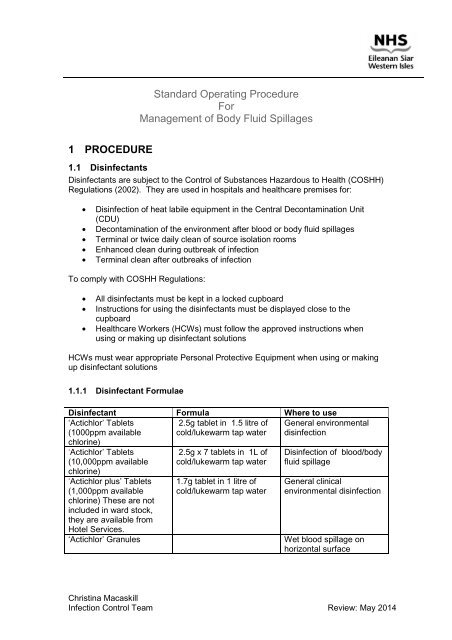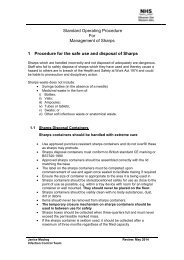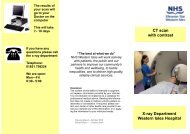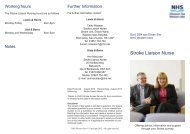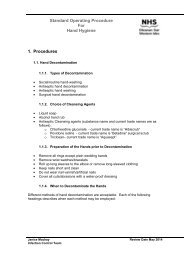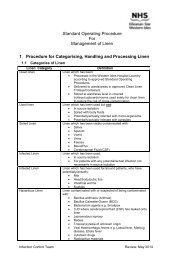Management of Body Fluid Spillages V2
Management of Body Fluid Spillages V2
Management of Body Fluid Spillages V2
You also want an ePaper? Increase the reach of your titles
YUMPU automatically turns print PDFs into web optimized ePapers that Google loves.
Standard Operating ProcedureFor<strong>Management</strong> <strong>of</strong> <strong>Body</strong> <strong>Fluid</strong> <strong>Spillages</strong>1 PROCEDURE1.1 DisinfectantsDisinfectants are subject to the Control <strong>of</strong> Substances Hazardous to Health (COSHH)Regulations (2002). They are used in hospitals and healthcare premises for:• Disinfection <strong>of</strong> heat labile equipment in the Central Decontamination Unit(CDU)• Decontamination <strong>of</strong> the environment after blood or body fluid spillages• Terminal or twice daily clean <strong>of</strong> source isolation rooms• Enhanced clean during outbreak <strong>of</strong> infection• Terminal clean after outbreaks <strong>of</strong> infectionTo comply with COSHH Regulations:• All disinfectants must be kept in a locked cupboard• Instructions for using the disinfectants must be displayed close to thecupboard• Healthcare Workers (HCWs) must follow the approved instructions whenusing or making up disinfectant solutionsHCWs must wear appropriate Personal Protective Equipment when using or makingup disinfectant solutions1.1.1 Disinfectant FormulaeDisinfectant Formula Where to use‘Actichlor’ Tablets(1000ppm availablechlorine)2.5g tablet in 1.5 litre <strong>of</strong>cold/lukewarm tap water‘Actichlor’ Tablets(10,000ppm availablechlorine)‘Actichlor plus’ Tablets(1,000ppm availablechlorine) These are notincluded in ward stock,they are available fromHotel Services.‘Actichlor’ Granules2.5g x 7 tablets in 1L <strong>of</strong>cold/lukewarm tap water1.7g tablet in 1 litre <strong>of</strong>cold/lukewarm tap waterGeneral environmentaldisinfectionDisinfection <strong>of</strong> blood/bodyfluid spillageGeneral clinicalenvironmental disinfectionWet blood spillage onhorizontal surfaceChristina MacaskillInfection Control Team Review: May 2014
1.2 <strong>Management</strong> <strong>of</strong> Blood/<strong>Body</strong> <strong>Fluid</strong> SpillageAsk a HCW to guard the area whilst the necessary equipment is collected<strong>Body</strong> <strong>Fluid</strong>SpillageWetBlood/Cerebrospinalfluid(CSF)If the spillageis on a verticalsurface/ceiling,use papertowels and‘Actichlor’solution todecontaminatebeforewashing with‘Hospec’solutionDried BloodIf the spillageis on a verticalsurface/ceiling,use papertowels and‘Actichlor plus’solution todecontaminatebeforewashing with‘Hospec’solutionAll other <strong>Body</strong><strong>Fluid</strong> (includingfaeces)NEVER use‘Actichlor’granules tosoak up urineas the mixreleaseschlorine whichis potentiallyDecontamination MethodDon appropriate Personal Protective Equipment (PPE).Apply enough ‘Actichlor’ Granules to cover spillage and leave for 3 minutes.If the spillage is still liquid apply more granules and leave for a further 3 minutes.Remove spillage with a scoop, if available, or ‘envelope’ spillage in paper towels.Discard into orange clinical waste bag.Clean spillage area with general purpose neutral detergent e.g. ‘Hospec’.Dry area thoroughly.Remove PPE and discard in orange clinical waste bag.Wash and dry hands.Return ‘Actichlor’ Granules to Disinfectant Cupboard.Don appropriate PPEPut paper towels over the spillage.Dissolve a 1.7gm tablet <strong>of</strong> ‘Actichlor plus’ in 100mls <strong>of</strong> cold/lukewarm tap water.Safely secure the lid and leave for 3 minutes.Invert container to ensure tablet is dissolved.Pour enough <strong>of</strong> the solution over the spillage to saturate the paper towels andleave for 5 minutes.Pick up paper towels and discard into orange clinical waste bag.Clean spillage area with ‘Hospec’.Dry area thoroughly.Remove gloves, discard in orange clinical waste bag, wash and dry hands.Don disposable gloves and discard any remaining disinfectant solution in sluicesink, rinse container.Remove PPE and discard in orange clinical waste bag.Wash and dry hands.When container is dry return to disinfectant cupboard.Don appropriate PPE.Soak up spillage using paper towels or incopad if necessary.Discard in orange clinical waste bag.Make up a solution <strong>of</strong> ‘Actichlor plus’ as above.Wipe over spillage area using paper towels soaked in Actichlor plus’ and discardin orange clinical waste bag.Clean spillage area with ‘Hospec’ if necessary.Dry area thoroughly.Remove gloves, discard in orange clinical waste bag, wash and dry hands.Don disposable gloves and discard any remaining disinfectant solution in sluicesink, rinse container.Christina MacaskillInfection Control Team Review: May 2014
harmfulRemove PPE and discard in orange clinical waste bag.Wash and dry hands.When container is dry return to disinfectant cupboard.1.3 <strong>Spillages</strong> in Patients own Home• Appropriate PPE must be worn• Soak up spillage with paper towels• Dispose <strong>of</strong> in domestic waste• Clean area with detergent, water and paper towels• Dispose <strong>of</strong> used paper towels in domestic waste• Remove PPE, dispose <strong>of</strong> in domestic waste• Wash and dry handsDisinfectant cannot be used on carpets or s<strong>of</strong>t furnishings because <strong>of</strong> thepossibility <strong>of</strong> permanent damage.compliantO Opportunity for improvementChristina MacaskillInfection Control Team Review: May 2014


